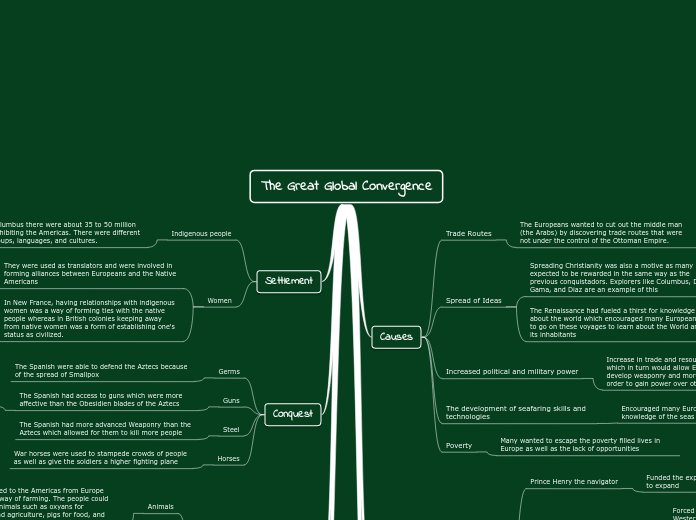The Great Global Convergence
Causes
Trade Routes
The Europeans wanted to cut out the middle man (the Arabs) by discovering trade routes that were not under the control of the Ottoman Empire.
Spread of Ideas
Spreading Christianity was also a motive as many expected to be rewarded in the same way as the previous conquistadors. Explorers like Columbus, De Gama, and Diaz are an example of this
The Renaissance had fueled a thirst for knowledge about the world which encouraged many Europeans to go on these voyages to learn about the World and its inhabitants
Increased political and military power
Increase in trade and resources would bring wealth which in turn would allow European countries to develop weaponry and more powerful armies in order to gain power over other countries.
The development of seafaring skills and technologies
Encouraged many Europeans to expand their knowledge of the seas and expand their empires
Poverty
Many wanted to escape the poverty filled lives in Europe as well as the lack of opportunities
The Portuguese Expansion
Prince Henry the navigator
Funded the expeditions which allowed for the Empire to expand
History in seafaring and navigation
Forced to find different routes as Portugal's access to Western Europe had been blocked by Spain
Found routes to North Africa, Atlantic Islands, and Brazil
Main goals
Military glory, conversion of muslims, slave trade, and gold
1433
First settlement at Arguin, North Africa
1460
Access to gold, enslaved Africans, and sugar plantations
1497
Vasco De Gama succeeded in rounding the Cape of Good Hope and reached the Calicut Port in India
Access to spices and samples of clothes to trade
1500
Gained control of gold trade
The Spanish Expansion
Columbus was granted funding by the Spanish crown in 1492 after he succeeded in finding a passage to the Indies
Landed in the Bahamas believing he was in the Indies and wanted to take the people as slaves and convert them to christianity. Word of his voyages spread in Europe.
Subjugated the Island of Hispaniola and enslaved the indigenous people in his second voyage
The Treaty of Tordesillas gave Spain everything in the West of the Atlantic
Settlement
Indigenous people
Before Columbus there were about 35 to 50 million natives inhibiting the Americas. There were different ethnic groups, languages, and cultures.
Women
They were used as translators and were involved in forming alliances between Europeans and the Native Americans
In New France, having relationships with indigenous women was a way of forming ties with the native people whereas in British colonies keeping away from native women was a form of establishing one's status as civilized.
Conquest
Germs
The Spanish were able to defend the Aztecs because of the spread of Smallpox
Guns
The Spanish had access to guns which were more affective than the Obesidien blades of the Aztecs
Meaning
Steel
The Spanish had more advanced Weaponry than the Aztecs which allowed for them to kill more people
Horses
War horses were used to stampede crowds of people as well as give the soldiers a higher fighting plane
The Columbian Exchange
Animals
Animals introduced to the Americas from Europe transformed the way of farming. The people could now use larger animals such as oxyans for transportation and agriculture, pigs for food, and horses to have a more nomadic lifestyle
Disease
Europeans brought diseases smallpox and syphilis to the Americas which led to most of the Native population to go extinct in the Great Dying. This also led to a decrease in farming activity causing many to also die of starvation.
Plants/food:
Food from the Americas to Europe and Asia led to a population increase as most countries now had food that could grow faster. This exchange also transformed the way we consume food today
People
The Transatlantic Slave Trade was when Africans were brought over to the Americas by Europeans to work on sugar plantation. This led to the repopulation of the world
The Impact of the Global convergence
Religious change
A large majority of the indigenous population in the Americas had been converted to Christianity
Global Economy
The trading and expansion of empires during the great global convergence led to the independency of countries' economies- Globalisation
Repopulation
The forced and voluntary migration of people during the great global convergence led to the repopulation of people across the global.
